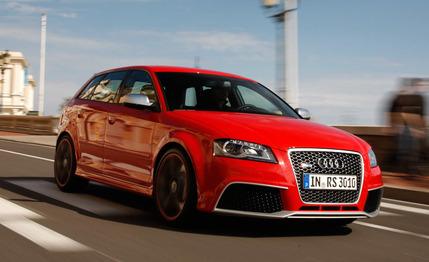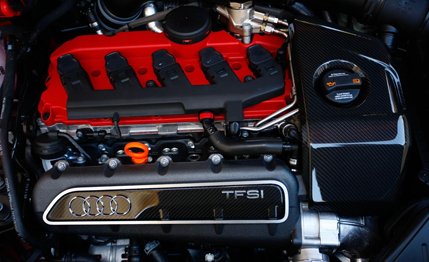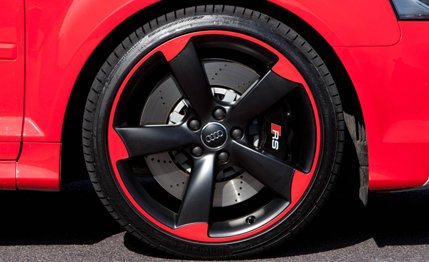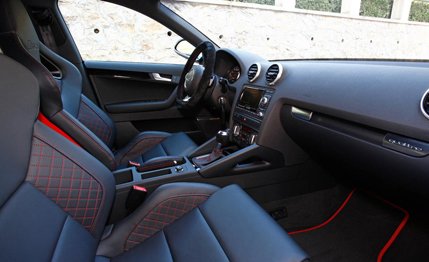
 First Drive Review
First Drive Review
After eight years in production with just minor face lifts, the current Audi A3 is about ready to retire. The next generation, less than two years away, was previewed at the Geneva auto show by the A3 concept. The production version will be the first car built on Volkswagen’s upcoming MQB platform (modularer querbaukasten, or modular transverse architecture). The RS 3 Sportback, which we drove extensively in the French Alps, is a great reason not to wait for that next model.
This super-hot hatch is powered by the same 2.5-liter inline-five that lurks under the hood of the TT RS. It packs direct injection, a single turbo, and variable camshaft timing, and it has precious little to do with the 170-hp, naturally aspirated engine from which it is derived. For one thing, it has double the hp, its 340 ponies peaking at 5400 rpm. There is surprisingly little turbo lag, and maximum torque, 332 lb-ft, is available from 1600 to 5300 rpm. With the five-cylinder soundtrack evoking the legendary, WRC-winning Audi Quattro of the ’80s, you don’t just feel the grunt, you hear it as well. We wouldn’t mind it if the RS 3 were a little louder, but engineers say they were hampered by strict noise-level regulations in Europe. Perhaps Audi should ask Lamborghini how it makes the Gallardo legal.


Lamborghini might be a bit perturbed by the feisty hatchback treading on Murciélago turf, however. With all that power channeled through a dual-clutch automatic to all four wheels, the RS 3 should spit itself to 60 mph in fewer than four seconds. (The last Murciélago LP640 we tested made the sprint in 3.2 seconds.) Top speed is governed at 155. In unperformance news, fuel consumption is about what we expect from a 2.5-liter. The RS 3 is rated at the equivalent of 26 mpg in the inflationary European cycle. It is easy to keep it above 20 mpg as indicated by the onboard computer, and even aggressive driving at extra-legal speeds never yielded less than 16 mpg.
Transmission (Option) Failure
Unfortunately, the DQ500 seven-speed wet dual-clutch transmission will be the only choice in the RS 3. Its programming is, of course, sporty, and the quickness of its shifts makes up for the lack of smoothness that occasionally accompanies manual inputs not anticipated by the software. But we’d love a traditional manual, particularly the six-speed unit stashed in Audi’s parts bin—the same trans that is available with this engine in the TT RS. But with a mere two or so years to sell this model, Audi wants to limit the number of derivatives and will happily direct those who are interested in shifting for themselves to the TT RS.
The chassis demonstrates the still-impressive capabilities of the outgoing PQ35 platform. In normal operation, the RS 3’s power distribution is front-biased, but if a loss of traction is detected, the shift to four-wheel go happens seamlessly and immediately. Nevertheless, even though you can turn off the stability-control system entirely, this car is no drifter. But it gets through corners quickly. Having front rubber that’s wider than that in the rear helps. At 235 mm, the fronts have 10 mm on the rears. Although this arrangement contradicts common aesthetic standards, nobody will notice unless he or she is under the car and paying very close attention. The electromechanical power steering is light to the touch but precise, and there is none of the artificial heaviness we’ve noticed in other cars using similar setups.


Looking the Part
The RS 3 Sportback is clearly distinguished from the regular A3 and S3 models by its giant front air intakes and wider front fenders—the latter made from carbon fiber. The RS theme continues with matte-aluminum side mirrors, but another common RS styling element, wide-set dual oval tailpipes, is missing from the RS 3. Its exhaust instead exits through two smaller pipes bundled together to one side. Something we wish weren’t available but is, is the option to accentuate the front air intakes and rear diffuser with aluminum strips that look like silver lipstick. We say no thanks, but Audi has been taking orders for RS 3s for a few weeks now, and the treatment is pretty popular.
Inside, the RS 3 is obviously an A3, albeit one with sporty overtones. The steering wheel is flat on the bottom, and the aluminum trim’s texture is supposed to evoke woven fiber—just don’t look too closely. Clearly, this basic design is eight years old, and the RS 3 doesn’t offer much inside beyond a VW Golf in terms of material quality or styling finesse. There are two types of sport seats available. Our tester had the less-extreme chairs (more-extreme seats shown below), which proved to be a happy compromise between comfort and sportiness.


No Competition, but a Bit of Hope
The RS 3 Sportback doesn’t have a lot of direct competition. BMW’s 1-series M coupe is closest in price and cachet, but with rear-wheel drive and a manual gearbox the only powertrain choice, it adheres to a different and more hard-core philosophy. Other all-wheel-drive rockets like the Subaru Impreza WRX STI and the Mitsubishi Lancer Evo are significantly less powerful and lack refinement. Actually, the RS 3’s most obvious rival comes from within the VW family: the Golf R.
Although Audi executives previously said the RS 3 would not be coming to the U.S., they’ve changed their tune. Now they say there’s a chance, but it depends on the success of the TT RS here. Given the current A3’s finite life cycle, the RS 3’s window of opportunity is small. VW has thrown down the gauntlet with the Golf R, however, and the RS 3 does a commendable job of reaffirming the corporate pecking order.